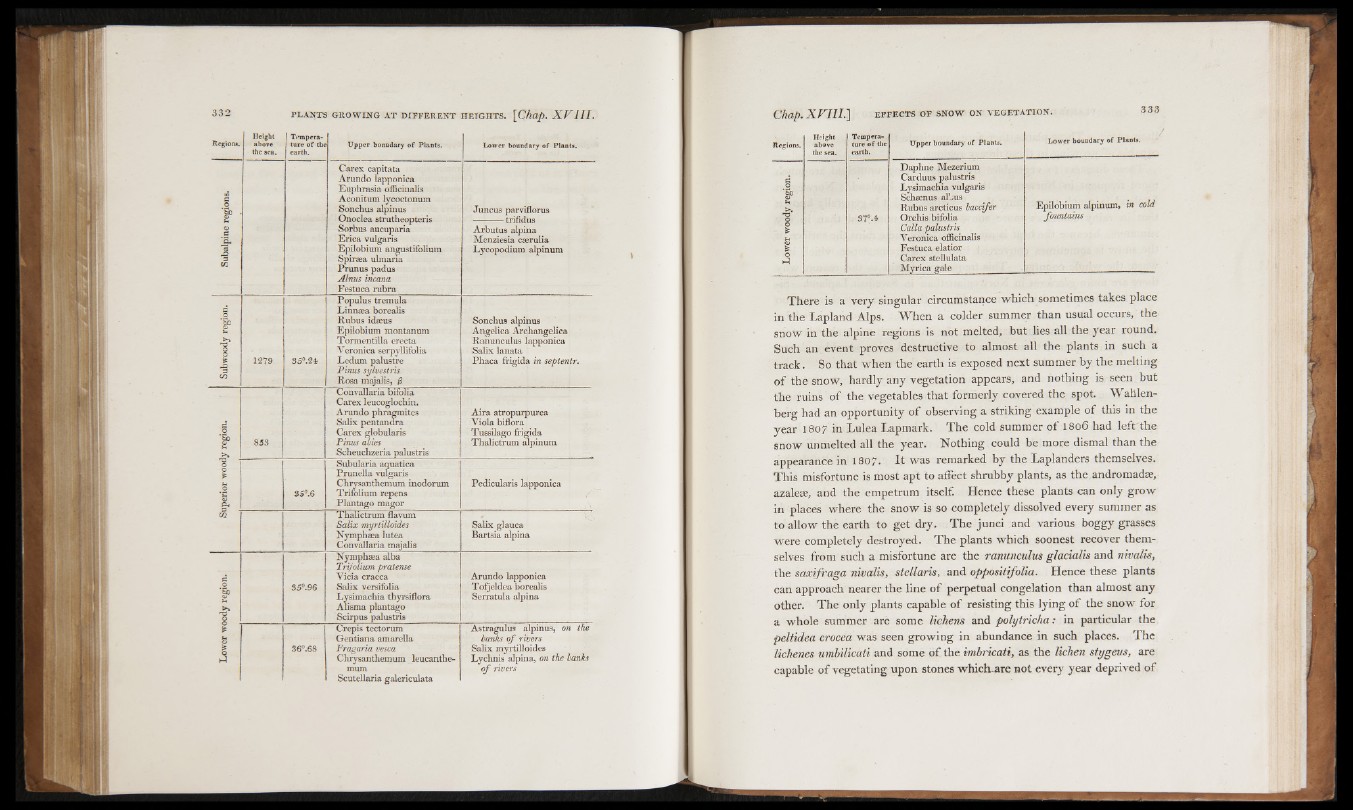
3 3 2 PLANTS GROWING AT DIFFERENT HEIGHTS. [Chap. X F I I I .
Height TemperaRegions.
above ture of the Upper boundary of Plants. Lower boundary of Plants.
the sea. earth.
Carex capitata
Arando lapponica
Euphrasia officinalis
c Aconitum lycoctonum
'So Sonchus alpinus QJ Juncus parviflorus Onodea strutheopteris -----------trifidus
Oa
Sorbus aucuparia Arbutus alpina
m Erica vulgaris Menziesia casrulia
,r> Epilobium angustifolium Lycopodium alpinum
USl Spiraea ulmana Prunus padus
Alnus incana
Festuca rubra
Populus tremula
g Linnaea borealis
’0So Rubus idaeus Sonchus alpinus Epilobium montan um Angelica Archangelica
H3 Tormentilla erecta Ranunculus lapponica
0 Veronica serpyllifolia Salix lanata
£ 1279 35°. 2* Ledum palustre Phaca frigida in septentr.
Pinus sylvestris
Rosa majalis, ß
Convallaria bifolia
Carex leucoglochin.
Arando phragmites Aira atropurpúrea
Salix pentandra Viola biflora
' bOO Carex globularis Tussilago frigida 853 Pinus abies Thalictrum alpinum
Scheuchzeria palustris
O Subularia aquatica
fi Prunella vulgaris
Chrysanthemum inodorum Pedicularis lapponica
2S°.6 Trifolium repens
cu Plantago magor
Ul Thalictrum flavum
Salix myrtilloides Salix glauca
Nymphaea lutea Bartsia alpina
Convallaria majalis
Nymphaea alba
Trifolium pratense
ö Vicia cracca Arando lapponica
p 3 5°.96 Salix versifolia Tofjeldea borealis
Lysimachia thyrsiflora Serratilla alpina
SS Aiisma plantago
0 Scirpus palustris
Crepis tectoram Astragulus alpinus, on the
a Gentiana amarella banks o f r ivers
i 36°.68 Fragaria vesca Salix myrtilloides
3 Chrysanthemum leucanthe- Lychnis alpina, on the banks
mum o f rivers
Scutellaria galericulata
Regions.
Height
above
Temperature
o f the Upper boundary o f Plants. Lower boundary o f Plants.
the sea. earth.
Daphne Mezerium
d Carduus palustris \
p Lysimachia vulgaris
Schaenus albus
>» Rubus arcticus baccfer Epilobium alpinum, in cold
H3
0 . 3 7 ”.* Orchis bifolia fountains
0pi Calla palustris
Veronica officinalis
% Festuca elatior
Q
>3 Carex stellulata
Myrica gale
There is a very singular circumstance which sometimes takes place
in the Lapland Alps. When a colder summer than usual occurs, the
snow in the alpine regions is not melted, but lies all the year round.
Such an event proves destructive to almost all the plants in such a
track. So that when the earth is exposed next summer by the melting
of the snow, hardly any vegetation appears, and nothing is seen but
the ruins of the vegetables that formerly covered the spot. Wahlen-
berg had an opportunity of observing a striking example of this in the
year 1807 in Lulea Lapmark. The cold summer of 1806 had leftrthe
snow unmelted all the year. Nothing could be more dismal than the
appearance in 1807. If was remarked by the Laplanders themselves.
This misfortune is most apt to affect shrubby plants, as the andromad*,
azalese, and the empetrum itself. Hence these plants can only grow
in places where the snow is so completely dissolved every summer as
to allow the earth to get dry. The junci and various boggy grasses
were completely destroyed. The plants which soonest recover themselves
from such a misfortune are the ranunculus glacialis and nivalis,
the saxífraga nivalis, stellaris, and oppositifolia. Hence these plants
can approach nearer the line o f perpetual congelation than almost any
other. The only plants capable o f resisting this lying o f the snow for
a whole summer aré some lichens and polytricha: in particular the
peltidea crocea was seen growing in abundance in such places. The
lichenes umhilicati and some of the imbricati, as the lichen stygeus, are
capable of vegetating upon stones whi.ch.are not every year deprived of